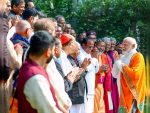By Mujib Mashal and Suhasini Raj
Gaindawas,May 15, 2019: Swati Yadav had lost count of the number of village campaign stops she had made since her morning began — was it 27, or 28?
She was doggedly stumping for a parliamentary seat through 100-degree temperatures in the northern Indian state of Haryana this month. But the biggest struggle in many places for Ms. Yadav, 30, was to get the crowd to focus on her own campaign as much as on the political fortunes of the men at the top of her party, Jannayak Janta.
“I am not asking for your vote because I am young, or because I am a woman,” she would repeat to the crowds after explaining her stand on critical issues. “I have an engineering degree, I have been running a company of thousands of people.”
Still, no speech could begin without explaining that she had the blessing of the party patriarch — though he is in jail with four more years to serve — and his son. And more of the crowd chants of “long live!” featured their names than hers.
For most of the few hundred women running for Parliament — results are due on May 23 — the campaign is a repeated exercise in playing up the protection of male politicians and shouting their names in stop after stop.
Even then, female representation in Parliament, at just over 11 percent now, is unlikely to increase much this election, if at all. (India’s poorer neighbors fare better: Nepal’s Parliament is 33 percent female, Pakistan’s is 21 percent and Afghanistan’s is 28 percent.)
This year, among the candidates that India’s political parties have fielded, only 8.8 percent have been women — a rise of about 1 percent over the 2014 elections, according to the Trivedi Center for Political Data.
It is a perplexing reality, as women in India have made it into leadership positions much earlier than in many Western democracies. The country has women in some of the most prominent roles. Women are key drivers of social movements, thrive in local village governance and are expected to vote in record numbers this year.
Yet they are still struggling to win representation in Parliament.
The imbalance is stirring discontent among women within political parties. Calls for finalizing legislation that would give women a minimum 33 percent quota of seats has picked up in recent weeks.
Shaina N.C., a spokeswoman for the governing Bharatiya Janata Party, recently told the local news media she was “upset and appalled” by how parties treat women, which she described as “lip service to our cause, manifesto after manifesto.”
India’s election is the largest in the world. With roughly 900 million eligible voters, polling is a challenge. Our animated video explains how the government pulls it off.
“There is a male chauvinistic mind-set in political parties,” she said, “so whenever a woman’s name comes up as a candidate, there are questions about winnability, about funding, unless it is somebody’s daughter, somebody’s daughter-in-law.”
Amrita Basu, a professor of political science at Amherst College in Massachusetts, noted that in the 2009 parliamentary elections, 11 percent of all women who ran won as opposed to 6 percent of male candidates.
“When women are nominated to run for national elections, they actually do well,” Professor Basu said. “The question is why a larger number is not nominated. I think it is some combination of societal prejudice, but also the growing criminalization of politics. To contest parliamentary elections is to be often subject to slander and abuse. Election campaigns have just become more violent, more corrupt, more dangerous.”
If it were not for women from political dynasties, local or national, the number of women in India’s Parliament would be even worse. Nearly half the women contesting seats in the current election are dynastic candidates, according to initial data from the Trivedi center.
But not even a prominent family name grants women immunity from attacks.
Shruti Choudhry, one of Ms. Yadav’s main opponents in Haryana and the only other woman out of the 16 candidates contesting the seat, inherited her father’s political fortunes when he died. The party elders put a turban on her as the sign of transfer of power.
Ms. Choudhry said the patriarch of Ms. Yadav’s party, Ajay Singh Chautala, recently claimed at a rally that Ms. Choudhry was “tying a stole around her stomach” as some sort of ploy to look pregnant and get sympathy votes.
Mr. Chautala is serving a 10-year sentence on corruption charges that his party supporters, including Ms. Yadav, say were politically motivated. His sentence ends in 2023, but he was out of jail on a monthlong furlough and on the campaign trail for his son and scion, Dushyant Chautala, and other party candidates.
“He said all this only because I am a woman,” Ms. Choudhry said. “Talk about my work! Expose me if I am dishonest!”
“It sickened me,” she added.
Asked for comment, an aide to Mr. Chautala said the party leader could not respond because he was back in jail.
If they want to win, women like Ms. Yadav know they have to play the game. For her, the campaign is a mix of tapping into the family wealth (they run a chain of private schools), the backing of the Chautala political dynasty, and her own credentials. Her father is also a local leader of the party and has contested elections before.
Ms. Yadav spent 10 years in the United States, earning an engineering degree and a master’s in business administration before starting work as a management consultant. She decided to return home and become active in politics after a horrific 2012 gang rape in New Delhi.
“That case made feel that I needed to come back,” Ms. Yadav said.
Ms. Yadav said that the entry barriers into politics are such that many women outside political dynasties are virtually shut out. Her wealth and her family’s stature gives her an advantage over many others.
“Only few step into it, even fewer are taken seriously and even fewer actually make it,” she said. “If I do well, it will send such a good message everywhere — that if you are a nobody and you want to enter politics you can, and you can make a difference.”
Many of the hopefuls from the coalition of smaller parties that she belongs to are banking on what is a local wave of disappointment with the incumbent Bharatiya Janata Party, or B.J.P. Prime Minister Narendra Modi is still popular, but his party’s star has faded enough that others think they can regain seats the B.J.P. swept in 2014.
In Haryana, Amar Singh, 72, said he voted for a B.J.P. candidate in the last elections because he was fed up with what he described as the Congress Party’s corruption. Now he is campaigning for Ms. Yadav.
“Modi’s promises, they were all lies. He is now acting like a dictator,” Mr. Singh said. “She has the energy to work. She is young, she is well educated.”
At every village, Ms. Yadav’s routine was largely the same. As dozens, sometimes hundreds, of villagers gathered around her car, she pressed the button to open the sunroof and popped out, pressing her palms together in respect before being handed a microphone.
Every speech began with her declaring that she had the blessings of Mr. Chautala, the veteran politician, and his son Dushyant. She promised to address water shortages and improve education and pension delivery. She spoke about her degrees from the United States and her leading a company of thousands.
And she ended with a wish that the younger Mr. Chautala becomes the chief minister of Haryana. It seemed to matter little that the local elections deciding a chief minister are not until October.
Athar Singh, 63, was among the thousands gathered at Ms. Yadav largest rally of the day, in Bhiwani. The men, and some women, chanted slogans of “Long live brother Ajay Chautala!” Occasionally, they chanted “Long live sister Swati!”
Mr. Singh, a farmer, said he knew nothing about Ms. Yadav. When pressed, he said he had heard that she was a “good, educated girl.”
But his real motivation had less to do with Ms. Yadav herself. “I am voting for her because Dushyant Chautala is a good man,” he said.
(The Washington Post)








